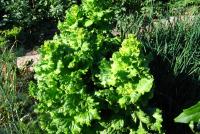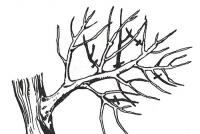Growing winter onions in the open field. Planting and care of winter onions
Onion is such an agricultural culture, the demand for which is difficult to underestimate. Not in one kitchen and not one hostess will not do without this culture. It is widely popular in hot dishes, and in salads, and in various sauces and seasonings, and in canned food. A saturation of vegetables with vitamins contributed to the fact that now many gardeners and gardeners prefer to grow it in the winter way. Indeed, after a long winter and spring avitaminosis, the green feathers of this vegetable culture necessary on the table as early as possible.
We all know the phrase "winter wheat" well, but the "winter onion" has not yet become widely used by our gardeners. Although at the present stage of this method of cultivation is gaining momentum and is becoming increasingly popular.
After all, this method of cultivation does not require any effort and cost, and without much hassle it allows you to get a very early harvest of such turnips. And the method of growing on the shoulder, even just beginners and gardeners gardeners.
Winter onions closeup
Not all varieties are suitable for winter cultivation. Especially for such a technique, breeders have brought out new varieties and hybrids that are able to overwinter under a snow ball and slowly grow and grow stronger in the conditions of a small day in the winter.
Popular varieties
The most popular winter vegetable varieties are:
- This variety is able to withstand frost to minus 18 degrees. He is completely unpretentious and requires almost no care. Crop begin to collect in 70-80 days after planting. Bulb regular round shape with white flesh.
- This variety has high germination excellent taste of the bulbs and early ripening. Harvest in early June. Turnips with white pulp of medium size: 100-150 grams.
- . It has the same properties and characteristics as Ellan, only its bulbs are larger under favorable conditions, reaching 300 grams.
- also has excellent germination and excellent taste. In addition, it has a long shelf life (up to 8 months).
- Also has early ripening, good germination. This variety has a more spicy taste of the bulbs and a high content of vitamin C in them.
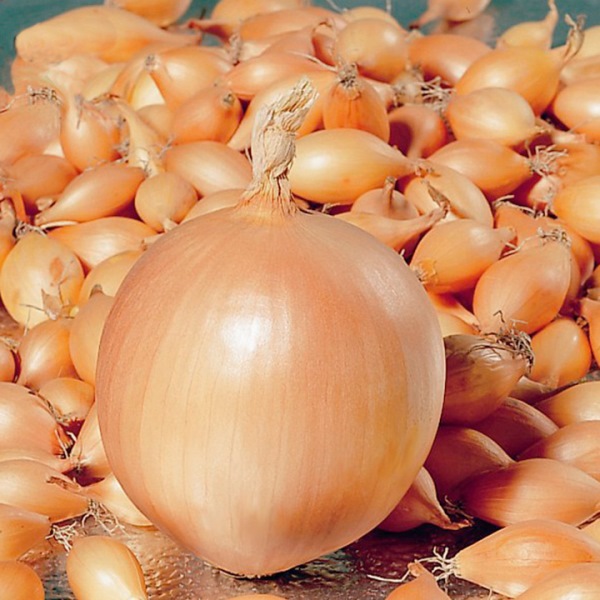
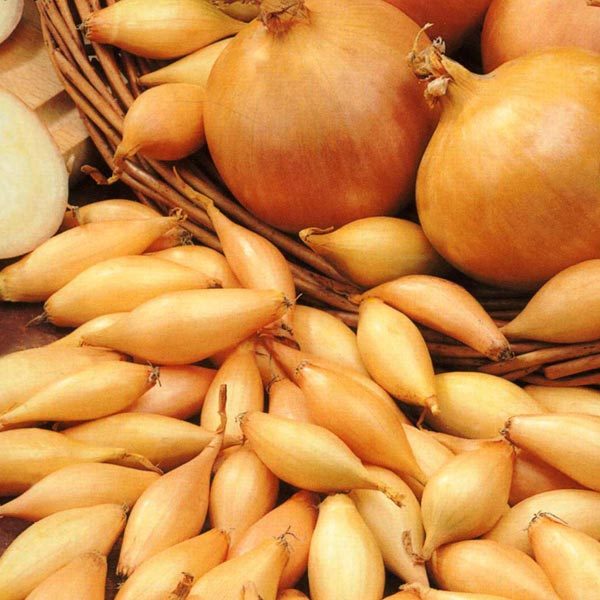
Winter onions, regardless of its variety, are distinguished by larger fruit sizes.
Planting and care of winter onions
Onion crops are usually harvested at the end of the summer season. After harvesting the bulbs are sorted and sent to storage. It also has its own economic advantages. For spring planting, bulbs are usually chosen to be at least 1.5 centimeters, since smaller ones before spring may simply dry out. These small onions are perfect for planting in the fall. Thus, the turnips, which could simply spoil more, will delight with their harvest. Germination winter onions somewhat less than spring, but considering the factor that only culled fruits are planted before winter, the risk of loss is not present in this case.
Before planting winter onions, no special soil preparation is required. Simply remove the weeds, and dig up the plot. To the composition of the soil, such a culture is also very undemanding.
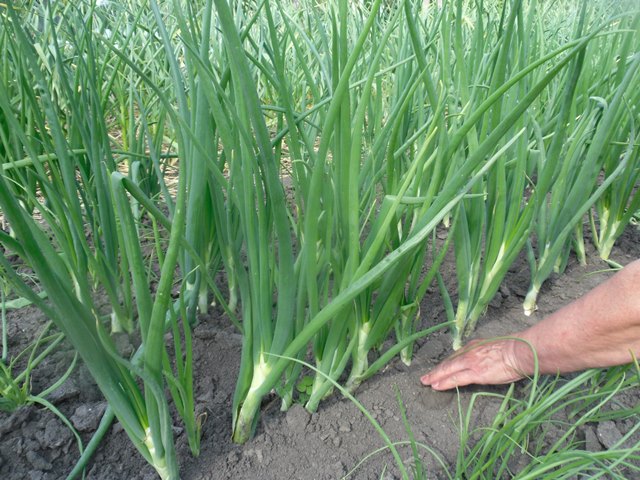 Winter onion care: weeding and loosening
Winter onion care: weeding and loosening
You can not plant a vegetable for several years in a row on the same place. If onions or garlic grew on the site, then such crops are recommended to be planted there no earlier than after 5 years.
Cauliflowers, legumes, cucumbers or tomatoes are good plant precursors.
There is also no urgent need to fertilize the site before planting the plant. It will be enough for those fertilizers that received onion precursors. You can only add a little ash to the soil.
The site should be in a well-lit place, it is better to choose a hill.
Onions planted at a distance of 8-10 cm from each other, in a previously dug furrow. The distance between the grooves should be 15-20 cm. The turnip is deepened by no more than 3 cm. Otherwise, in the spring it will be hard for the bulbs to break out of the ground and slightly tamp. This is what distinguishes the spring planting from the autumn; in the spring, the heads are buried deeper into the ground. Specially watering the area after planting onion heads is not necessary.
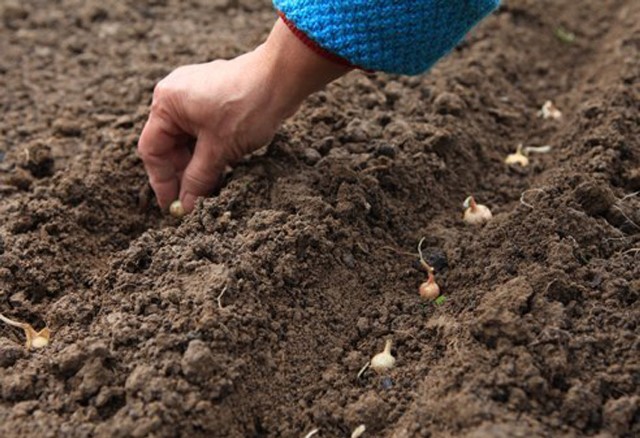 Planting winter onions
Planting winter onions Planted bulbs in the second half of August - the first half of September. The landing dates vary by region. In any case, it is necessary that the onions should be planted no later than 4 weeks before persistent frost. The plant needs to take root well and get stronger before the onset of cold weather.
Before frost be sure to warm the area with a bow. To do this, cover it with dry leaves, tops of legumes, agro-weed.
As soon as the snow melts in the spring and the earth begins to warm up, it is necessary to ensure that the culture has full access to sunlight. For this shelter is removed. Beds with the onset of spring and heat must be mulched. T such a procedure will not only retain sufficient moisture and heat, but also protect against overheating.
If it is warm during the day, but there is a threat of night frost, it is necessary to cover the site with agrofiber for the night. It not only warms plants, but also does not interfere with air circulation. You can also use film as a cover, but the access of oxygen to the culture will be very limited.
In spring, seedlings can be fed with a weak solution of mullein or chicken manure. Nitrogen fertilizers can also be used.
Watered the area with onions in the spring, after the first shoots. Subsequent watering is carried out with a break of two weeks.
Harvest of winter onions begin to collect in early June. To harvest, you must carefully dig up ripe turnips.
Advantages and disadvantages of the method
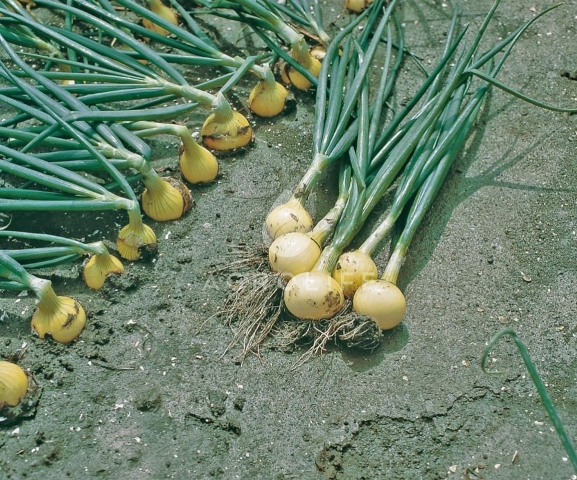 Harvesting winter onions
Harvesting winter onions The advantages of this method are quite a few, it is:
- Efficiency. Onions are planted before winter, which could not live to see spring.
- Excellent taste.
- Unpretentiousness and undemanding in care.
- Large sizes of turnips.
More than a thousand years ago, onions began to be grown in Iran, Turkmenistan and Afghanistan. The culture was planted on mountain slopes, which determined the depth of the root system.
Thanks to the ability to survive on a small layer of earth, the bow has developed the ability to rest in a state of rest with a lack of moisture. Dry scales protect it from damage and drying. Currently, onions are widely distributed as a culture.
It is considered capricious for growing. If the weather is dry, the onions begin to throw out the arrows, and if wet, they rot. However, gardeners have figured out how to grow it.
Onions need to be planted in the winter.
Onion sets: how to choose
The size of the bulb determines the category: first, the diameter of the bulb is 1-1.5 cm; the second is 1.5-3 cm; third - more than 3 cm; ovusuzhka - diameter less than 1 cm. For sowing in the winter it is better to use sevok first category or ovsuzyuzhku. Why?
Small bulbs, as a rule, do not persist until spring, they dry out. Therefore, it will be better if the winter onions are planted in the ground.
Here he will spend the winter well and in July will give a good harvest. A second and third category sower, that is, a large one, it is better not to plant in the winter, he gives arrows. For the cultivation of winter onions using special varieties and obtained by crossing hybrids that are able to form bulbs and do not give arrows.
Popular varieties of winter onions
Each owner chooses what kind of onions he needs. The choice depends on the result you expect from this culture. Therefore, you need to know the winter varieties of onion sets.
- Stuttgart Riesen - this variety owes its popularity to early ripening. The culture bulbs have a flat-rounded shape, dense, large, have a pungent taste, are well preserved and yield high yields. Centurion is a high-grade variety. Few arrows, well preserved, does not fall ill, has a high yield. The bulbs of the same size covering the outer layer of the scales dry. In the root zone there is a bottom. Shakespeare - early variety, it has little arrows, it is well preserved, has large onions of dark yellow color. The flesh is white, juicy. The scales are very dense. Radar - this variety can be used only fresh. It is unsuitable for storage due to color.
- Baron is also great for winter planting. Ripens early and contains more vitamin C than other varieties. Differs in the big size of bulbs and an acutate taste. Especially good when fresh.
How to prepare the ground for planting
To plant a winter bow, choose a well-lit place with a drain of rainwater, so that the water does not stand and when the snow melts in the spring. They make a bed one meter wide and 20 cm high. It is cleaned of the vegetation that grew on it.
It is better to plant onions on the place where they grew cucumbers, tomatoes or potatoes. Well disinfect the soil. For this purpose, copper sulphate is suitable, with no more than 1 tbsp being placed on a bucket of water. spoons. This solution is watered garden bed.
In order for the onion sets to produce large, strong bulbs, humus, peat, superphosphate and a bed should be dug up along with fertilizers.
Dutch onions and garlic. Winter planting technology. Company VASSMA Retail.
When to sow onions
Planting winter onions provides an opportunity to harvest from July to mid-August. Planting date - October. The bulbs need to be allowed to take root before severe frosts. When planted early, planting sprouts before the onset of cold, such plants will not survive the winter, they will die. When to plant winter onions?
Need to look at the weather, it will tell the exact date of sowing. Approximately it will be the middle of the month.
Planting onion sets in winter
All gardeners are looking forward to the time when you can plant winter bow. First you need to prepare planting material. His sort out. This can be done in the simplest way.
Holes 1 cm in diameter are cut in thick cardboard and seeds are sifted through such a sieve. Those that went through the holes are suitable. After preparing the soil for sowing, you need to level and compact the bed.
Then along its entire length, shallow grooves are made, five centimeters deep and at a distance of 15 cm from each other. Well dried seeds are sown gently in the groove at a distance of 3-4 cm.
Sevok close up to a depth of 2-3 cm, and then carefully covered with soil mixed with peat and humus. If sevok planted at a greater depth, the onions may not germinate and die. They just do not have enough strength for it.
Planting winter bow takes a lot of time and patience.
How to protect sevka from freezing
To sevok well endured winter frost and in the spring gave strong shoots, you need to cover the soil with mulch from peat or humus. So the moisture will remain, the seeds will root well. With the onset of severe frosts, cover the bed with foliage and straw.
And when the snow falls, hold it. If you plant correctly and cover Sevok in time, then in the second month of summer you can already eat winter onions. Spring, when the snow melts and thaws the soil, you need to remove the mulch from the garden bed. After the seedlings germinate and the first leaflets appear, feed them with a liquid solution of manure and bird droppings.
Onions in the winter: what care is needed
With the onset of spring, seedlings sprout and begin to grow rapidly. But not only they. Weeds are more unpretentious, there are always a lot of them, and we need to fight them. At this time, you need to loosen and weed between the rows. The soil is usually stored in the fall.
It is enough for the growth of onions before harvest. But it happens that more than a month is very hot and the soil dries up. Then you need to water it several times during the summer season.
Winter onions need the same care as usual. If arrows appear, leave a few pieces to collect the seeds, and remove the rest.
Onions pests: how to deal with them
Winter bow is damaged by onion fly. This is a dangerous pest, if it gets to your landings, it will destroy the entire crop. Signs of its appearance are the white larvae. They crawl in the bulbs, eating them.
Adult insects are very similar to ordinary flies. It appears in the middle of May and gives rise to offspring three times before the onset of cold weather. Only dry weather can reduce fertility. To prevent onion crops, you can cover them with a net for protection.
It repels the pest by the smell of calendula and marigold. Therefore, plant a spring bed where the winter onions grow, with these flowers. You can spray the plants with infusion of wormwood or tansy.
Diseases of Onions: Fighting them
Winter onions, the cultivation of which requires knowledge of agricultural technology, is affected by fungi.
- Rust is one of them. Small yellow spots on the leaves appear from mid-summer. The best environment for the development and spread of this disease is warm and humid weather. Gray rot often appears during harvest. Dry onions well before storing. Crude will rot. Seeds and bulbs are exposed to powdery mildew, which persists in them all winter and is often false. If the weather is warm and humid, the infection can strike the entire onion plantation. This disease can be identified by elongated gray spots, which increase in size until the plant dies.
In order to avoid the disease by fungi, it is necessary to alternate the planting of garden crops at the site and when storing the onions, ventilate the room well.
Landing for the winter: what are the advantages
- There is no need to preserve onion sets in winter. Large bulbs grow from small planting material. A winter onion, the cultivation of which does not require care, does not produce arrows. Onions mature early and are stored for long. In the photo, winter onions are clearly visible.
- This culture is less exposed to onion fly infection. It takes less time for planting. The family budget benefits - in the fall, planting is cheaper.
What can be the cause of failures in the cultivation of winter onions
- Water retention in the beds in the spring. This leads to the drenching of the bulbs. Deep embedment of seeds into the soil. Early planting of seed. This leads to the germination of bulbs before the onset of frost. Poor mulching of the soil, which leads to repeated thawing and freezing of the bulbs.
Growing perennial onions of different types
Young leaves of onions are tasty and healthy, they should always be present on our table. For green vertices, many planted a turnip, but his perennial relatives have much more interesting feathers. It is not only richer in vitamins, but also softer in taste.
Equally important is the crown time perennial bows - early spring, when in the garden still did not have time to grow. Growing perennial onions does not require special care, they are unpretentious and hardy. They all grow well on fertile, non-acidic soils. There are four honors in my garden: batun, slizun, shnitt and walking along the beds - multi-tiered.
Perennial Bows - Types
Batun - beam on beamBatun among perennial bows - one of the most popular. It is also called winter, Russian or Siberian. By the end of the first year of life, the plant forms small curtains from 3-5 branches.
Then every year the bushes grow and can consist of from 30 to 60 branches. However, as early as the 3-4th year, the yield decreases, the leaves grow coarser, the plant begins to shoot out earlier, the first feathers of this onion appear immediately after the snow melts.
For the whole season, 3-4 crops can be harvested from the garden with good care. Early cuts do not harm the batun (if after them the landings were fed, watered, spilled).
Within a month, the plants grow so much that it is impossible to distinguish them from those that were not cut. In summer you need to ensure that the onions do not bloom. All peduncles are cut with a sharp knife. By winter, the arrows of the onion-batun dry out.
They must be removed, because pests can hibernate in them. garden plots the onion batun is most often propagated by dividing the bush. It is better to do in the summer, after flowering. With this planting, the first harvest can be removed as early as next spring.
If you sow onions with seeds in mid-June, the harvest will be for the second year. The green stick of the batun usually remains tender and tasty until it starts to throw out the arrows. Therefore, in recent years, I began to grow it through the sowing of Chernushka.
I spend it in two terms. In March - April, as soon as the soil permits, I sow very thickly, then the leaves are softer. I start harvesting at the end of July, thinning out the plants and pulling them out entirely.
If I do not have time to pull out all the bushes before frosts and some of them remain before winter, in the spring I cover planting with a film. As soon as the feather grows well, I dig them out by the roots. In July, then the plants go into the winter in the phase of 3-4 leaves.
In the spring I select the largest ones and sit on a separate garden in cut furrows 15 cm apart from each other, plunging leaves into the soil. As soon as new ones grow, I roll up. And so three times in the summer.
Watering planting, always add a grassy infusion to the water. I pull out the bushes entirely with a bleached thick juicy leg, almost like a leek. With such accelerated cultivation, hybrids work well F1 Parade, F1 Performer, F1 Green Banner.
With “long-playing”, early-maturing varieties proved to be well. Russian winter and wales. Hybrids without shelter can freeze out in the winter. Reference on the topic: Growing onion batun If you plan to grow onion batun in one place for 3-4 years, do not sow the seeds in early spring.
This practically does not accelerate the receipt of products, but in the next season the number of shooter plants significantly increases.Slizun - perennial onion for the nursery bedsOnions-slizun - squat grassy perennial with juicy, flat, wide leaves.
If they are cut off, they release viscous transparent viscous mucus, which, obviously, gave the name to this type of onion. Blooms in the second year. Before flowering, the umbrella "looks" down.
As soon as the first tender lilac flowers begin to open, the arrow straightens out. Despite the fact that growing slizuna does not present any particular difficulties, it is quite rare in our gardens. And obviously not able to compete in terms of popularity with the bow-batun.
However, to have at least not many plants of such onions on the site is worth it! Particularly valuable is the onion-slizun in that it contains mineral salts of iron, manganese, potassium, zinc, molybdenum, nickel, and also essential oil in large quantities. Therefore, it is very useful in anemia.
At the same time, the taste of its leaves is pleasant, slightly sharp, with a slight garlic-onion odor. They are happy to eat children. Succulent and tender leaves remain almost the entire vegetation period. The more often the leaves of the onion sliz cut (after 2-2.5 weeks), the more tender they will be.
The slizuna bush has been growing in my place for more than seven years and now occupies an area of about half a meter. I cut it with bunches together with a piece of rhizome, in this case it quickly gives new young shoots. And the bush does not thicken so much. For the winter I sprinkle it with a bucket of humus.
This, in general, is the whole care. He survives even the weeds himself (except dandelions). I do not use the slizun for winter forcing. He has a powerful root system, from one pot it turns out very little green. Do not discourage him and beautiful curb.
Although this onion blooms very beautifully, giving out large purple balls on thin arrows, he has “rare” thickets. But on the site can live even in the most extreme conditions. In more detail about growing onions slizuna here
Tiered (walking) bow - also from perennial
In the spring, one of the first among perennial onions grows a multi-tiered, or walking bow (viviparous, horned, Egyptian, Canadian ...). In the first year it looks like a baton with hollow hollow leaves.
On the second, it forms a floral arrow with several tiers (we have up to three) of small onion-bulbbots. The largest bulbs (5 pieces up to 2 cm in diameter) are formed on the first tier at a height of 60-80 cm. They immediately begin to grow leaves 10-15 cm long.
Under the weight of onion stalks fall on the earth, and the bulbs begin to take root. So there is a resettlement of this onion. The main crop of greenery is obtained from underground bulbs.
They are large (3-7 cm in diameter), form nests and are very similar to shallots, but do not ripen and are poorly stored. The leaves are dark green, very tender, juicy and tasty. They are used in food, as well as any young feather.
But onion bulbs can be boiled and fried, as well as put into the winter harvest: pickle separately and with other vegetables. The onions that have taken root become unsuitable for conservation, therefore, for the shooters, they must be tied to supports.
And in order to get large bulbs, you should pinch the plant after the formation of the first tier.If aerial bulbs are not needed, then the feather is cut from the whole bed.
Then it will be able to grow one or two more times, it depends on the care. The taste and tenderness of the leaves are maintained until the first tier of the bulbocchi appears. Plantings should be regularly updated (every 3-4 years). You can split the nest or use aerial bulbs. Bulbochki planted in August and September, so they had time to take root before winter.
Onion Schnitt - the most beautiful of the perennial onions
I took a place in the flower garden to the luxurious shnitta bushes, its neat purple bouquets painfully beautiful during the flowering. I cut off his feather only in early spring. In summer, the remaining leaves grow coarse, and there is quite a different greenery on the beds.
Schnitt leaves are thin, fragrant, not too sharp in taste, with small delicate white bulbs, tightly covered with a dry shirt. They are consumed only fresh and in no case are subjected to heat treatment. Schnitt is grown only in perennial culture.
If his coat does not clog the weeds, then he can grow in one place for 5-7 years or more. But I seated him once in 3-4 years, then the leaves and the flowers are larger, and the bushes are neater. And still schnitt is well suited for forcing.
It is early ripening - it is ready for cutting in two weeks after the start of regrowth. To do this, I dig up 3-4-year-old bushes, divide them into pieces so that they fit well in a pot, or plant them in a box, deepening them by 4-5 cm. My family loves green onion cake.
I use for it the gentle feather of perennial onions. The multi-tiered onion does not have a rest period. As soon as it gets into favorable conditions, it immediately begins to germinate, therefore it is very good for forcing.
I prefer to get a green feather in the winter from underground bulbs, for which I keep this bow before planting in the cellar with a whole nest. Then I divide it into bulbs and plant them tightly one to one in pots. In the heat of the greens grows in a month.
Bulbs can also be planted, but even with a very dense planting, the feather will be more modest. hard cheese, 6 boiled and one raw egg, salt to taste. Finely chop the onion and mash it with salt. Scald nettle with boiling water and drain in a colander to drain the water, then squeeze with hands and chop with a knife.
Grate the cheese, finely chop the boiled eggs. All components of the filling mix well. Spread the dough in half. Both halves roll out into rectangles of size 30x40. On one - bottom - put the stuffing, departing from the edges of 2 cm.
At the top make cuts, slightly stretch and lay on the filling. Edge pinch. Top of the cake smeared with yolk.
Bake for about 25 minutes at a temperature of 190 degrees. © N. SOLONOVICH, scientist agronomist Photo L. MOGILEVICH (except for multi-tiered onions)
Below are other entries on the topic "Cottage and garden - do it yourself"
It is no secret that ground vegetables are tastier and healthier than greenhouse vegetables, so spring gifts from the garden are so desirable. And the first among them are perennial bows. Of course, we have paid attention to them before. But hardly anyone in the garden has any complete collection.
That's why we decided to talk in detail about perennial onions. The genus Allium (onion) includes half a million species, but only two hundred of them grow in Russia. Almost all of them have high nutritional, medicinal and decorative properties, but, unfortunately, they mainly grow garlic, onion, leek and shallot.
A batun, chives, slizun, fragrant, multi-tiered, oblique, wild garlic is rarely seen in gardeners. Many years of onions are rich in essential amino acids, vitamins, perfectly affect metabolism and immunity, their essential oils stimulate appetite and improve digestion. And only volunteers with strong bactericidal properties know everything about volatile substances. There are other advantages in perennial onions: simple agricultural technology, winter and frost resistance (can withstand temperatures up to minus 40 °), resistance to diseases, pests and good harvest within 3-5 years, even with multiple cutting.
Unlike bulb, perennial onions form a false bulb, which under favorable conditions continuously produces leaves. And since the dormant period is short, they are suitable for cultivation in greenhouses or rooms. Under perennial onions, they allocate a plot outside the main crop rotation - it will be used for 5-6 years.
Well, if the onion area in the fall and spring will not flood the water. The roots of this plant are stumpy and lie at a depth of 20-30 cm, so the soil must be very fertile, of light mechanical composition, neutral or slightly acidic (pH = 6-7), without rhizomatous and root-weeping.
If horsetail or horse sorrel grows on the site, then liming is necessary first. The soil is prepared the same way as for onions: in the fall, manure, humus or compost (10 kg per sq. M) and phosphorus-potassium fertilizers are brought under digging, and in spring rakes add nitrogen. Perennial onions are propagated by delenki or sow. Seeds are small, especially in shnitta, and germination is low.
It is better to sow fresh, and if they have lain down (germination rate is below 80%), then the seeding rate should be increased. Before sowing, they are necessarily disinfected. Depending on the type of soil, seeds are placed on a flat surface, ridges or ridges, the last two methods will be useful in lowlands and on cold ground.
In open ground sown in April-May and be sure to mulch with peat or humus (0.5-1 kg per square meter). Seedlings and seedlings are planted in the spring-summer period. In the second and subsequent years, regular feeding is necessary (in early spring and after each cut of leaves - 10 g per square meter of potash and nitrogen fertilizers and 15 g of phosphate fertilizers).
In the first year, a plant with one or three branches is formed, and the next there are as many flower arrows with spherical inflorescences. In late April - early May, the shnitt, the batun and the multi-tiered grow, and later the slipper and fragrant grow. Therefore, planting a set of perennial onions, you can create a green conveyor. To get the greens in the winter, a 3-4-year-old planting material is picked from the fall and dug.
Placed in boxes, sprinkled with earth or peat and kept up to disembarkation at a temperature of 0 - plus 2 °. Chives (chisel, speeding) is appreciated for its decorative effect, high content of vitamin C in early spring and good winter hardiness (it does not freeze even in the High North).
It has a fisty, hollow, awl-shaped, green with a wax bloom up to 40 cm in length. The plants grow strongly and in the fourth year produce a powerful bush. Flower arrows straight, thin, slightly longer than the leaves.
On them are small spherical inflorescences with flowers of various colors: from white to purple-violet. This onion has two varieties: central Russian (bushes strongly, leaves quickly grow up to 25 cm, but also quickly grow coarse) and siberian (leaves are larger, up to 40 cm long, grow more slowly and later, but last up to two months). We have everywhere zoned Medonos and Nemal, and Bohemia, Crocus grow better in areas with mild winters.
Medonos - medium early variety. On its plants in the spring dark green semi-sharp leaves grow together. They can be collected for a long time, yield 1.7-2.5 kg / sq.m.
Chemal - strong-pure plant with sharp-tasting leaves up to half a meter long. open ground chives seeds (consumption 1-1.5 g per 1 square meter) are sown to a depth of 2 cm according to the scheme 5x25-30 cm, and delenki are planted in rows with distances of 30x30-50 cm. In the second year from the first decade of May to At the end of September, the feather is cut off, and in the annual crop they are completely removed when the leaves reach 30 cm. Skoroda, or chives. Chives pop first Batun (Tatar, sand, buton, Chinese) looks very similar to young onions, but its leaves are more powerful and twice as rich as vitamin C. All the variety of forms of a batun is represented by three subspecies. russian small, no more than 40 cm, dark green, spicy leaves.
They branch heavily (in the third year they give 30-50 branches), they do not freeze out even in the most severe winters with frosts up to 50 °. Russian winter - A new medium early winter hardy branching variety.
Its dark green, semi-sharp leaves do not grow coarse for a long time, and the bush does not turn out to be an arrow. Medium in power, branching and winter-hardy batun japanese subspecies. It includes several varieties. Batun or Tatar or Welsh onion.
For okroshka and summer cabaret there is no better batun Salat 35 - early ripe semi-sharp zoned variety. In the second year gives two or three branches. Each has five dark green, up to 45 cm long leaves. Plants shoot out early, so the period of collecting greenery is short.
April - early ripe variety. The leaves are tender, juicy, semi-sharp taste, bright green, up to 40 cm long. Arrow late. May - strongly branching late ripening variety. The leaves are dark green with a strong waxy coating, a pungent taste and quickly coarse.
Parade - variety for annual crops with high (up to 60 cm), powerful, erect sheet rosette. The leaves are tender, juicy, green with a bluish tinge, do not become coarse for a long time. The most thermophilic bows from chinese subspecies.
It gives only 3-5 branches, but very large (up to 130 cm tall) with juicy, spicy taste and large diameter leaves. There are no zoned varieties, but on private gardens occurs.Slizun bow or drooping bow (Allium nutans).
The Shlyrokolistny varietal slizun - in May, an excellent vegetable, and in July for a bouquet will fit. In the annual culture of the batun, seeds (consumption 1–1.5 g per square meter) are buried in early spring and completely removed the plant next spring. Usually sown with the distance between the lines of 25, and ribbons - 50-60 cm. With perennial culture, the planting season lasts from mid-June to August.
Delenki are planted in the middle of summer in an ordinary way according to the scheme 20-30x50 cm. The leaves are cut off after a year at a height of 25 cm. During the season - up to three cuts, but the latter is no later than August. slizuna (drooping bow) leaves are flat, up to 30-50 cm long and up to 2 cm wide.
They are very fragile, but juicy, with a pleasant onion-garlic taste, without strong sharpness. Moreover, they do not become rude and retain their virtues until the very autumn. Slizun is resistant to peronosporosis and adverse conditions, is rich in ascorbic acid, bioactive polysaccharides and salts important for health.
He is advised to eat in case of anemia and cardiovascular diseases. Branched onion, Dzhusay or Allium fragrant (Garlic chives). A magnificent sweet onion variety of piquant. This onion is grown only as a perennial.
Branches the whole season and forms a squat plant with a cylindrical shortened "onion". In the second year, it grows up to four branches and several flower arrows up to 60 cm high, each ending with a spherical inflorescence umbrella. Seeds (1 g per square meter) are sown in April-May on ridges, and delenki are planted in June-August in rows 30x40.
Cut the leaves start at a length of 25 cm. For the season, up to 7 kg of greenery per square meter is collected. In Russia, only one variety is zoned everywhere Green. It is a semi-sprawling or compact plant with a powerful rhizome and large, juicy leaves.
They have a delicate, slightly sharp taste, with a garlic smell. Recently, breeders created a new winter-hardy, middle-ripe salad variety. Broadleaf. It has a squat, false stem and long, wide, lanceolate leaves with a mildly sharp taste and smell.
They are rich in ascorbic acid, retain their tenderness until late autumn. For the season, with 1 square meter of Broadleaf plantings, you can collect 3 kg of greenery. Scented onions is good because there is little fiber in it and it retains tenderness all season.
Its belt-like leaves, unlike a slizuna, are without sharpness, richer in vitamin C (up to 100 mg%) and grow continuously until deep autumn. In the first year two shoots are formed, on each one - 3-6 leaves 30 cm long, and in the second year-flowered arrows with white flowers, gathered in a simple umbrella. The flowers exude a pleasant smell, like hyacinth or almond. From fragrant onions, the variety is zoned Astrologer (in all zones).
Its dark green leaves grow quickly up to 60 cm long, the leaf width is 1.5 cm. The variety has a semi-sharp, mild garlic flavor. A new promising mid-season variety has been developed. Piquant.
It is more winter-hardy and richer in vitamin C. As you can see, perennial onions, including varietal onions, become more and more every year. Fresh, they are added to salads, as seasonings for the first and second courses.
They can be dried, pickled and sour, while beneficial features perfectly preserved. Hopefully we convinced you dear readersthat it is time to think seriously about the onion corner! Materials used:
- L. Agafonov, breeder - Household farm № 4-2001
Please rate this article in our ranking:
Advantages and disadvantages of growing winter onions All gardeners are well aware of how hard it is to keep sevok until spring. When growing winter onions there is no need for this. Nothing rot and release arrows. Another advantage of this method is that the heads grow very large, since the landing time in the spring will not be missed anyway. It is absolutely not necessary to water the onions until mid-May, as the soil still retains enough moisture. The released time can be devoted to planting and caring for other cultures. Winter onion varieties ripen two to three weeks earlier than the usual spring ones. Onion soups can be taken at the end of May. Of course, this method of cultivation has its drawbacks. The main thing is that the yield of winter onions is slightly lower than that of spring. In addition, it is believed that its heads are kept a little worse. Winter varieties of onion seed: the rules of choice For winter cultivation, you can take only hybrids and varieties of short - medium daylight hours. They begin to form onion already at 12-14 hours. Southern onion varieties for winter growing are not suitable. Varieties intended for spring planting are also not recommended. The fact is that they endure wintering much worse, and, while freezing, they start shooting. Most often, as in the case of spring onions, for planting winter use varieties of Dutch selection. Shakespeare One of the most popular varietiesintended for winter cultivation is Shakespeare. Heads of this onion ripen early enough (grow in 75 days). Their characteristic features include a rounded shape and big sizes. If we compare Shakespeare's onion winter with other varieties, we can note, above all, much more dense integumentary scales. Because of this, it can withstand temperatures of -18 g. without snow cover. For comparison - most varieties of winter onions begin to freeze even at -15 gr. The color of scales is brown. Winter Shakespeare's bow is distinguished by white juicy pulp. The taste of this variety is considered to be semi-sharp. Caring for him in the usual manner. Variety Radar Unlike Shakespeare, another promising winter variety - Radar - has an average ripening period. Its popularity is primarily due to the excellent taste of the bulbs and their very good keeping quality. The color of the scales in this variety is light yellow. Another distinctive feature is the large size of the heads. Grow bulbs in 150 gr. no difficulty. In some years, with careful care of the Radar variety head, they can reach 300 g in weight. Vintage onion Radar winter gives more than good. Grade Allan Grade Allan refers to the short-day form. Straw-colored bulbs have a rounded shape. Their weight can reach 80-120 g. The flesh is white, has a sweetish taste. The Allan variety is ripening already in June, when the old onion stocks have been consumed, and the spring heads have not yet matured. Other varieties The winter varieties of onion sets described above can be classified as the most popular. However, there are others that also deserve attention. For example, very often summer residents of central Russia grow Senshui winter onions. You can also plant in the fall such varieties as the popular and well-known Studgarten Riesen, the Sturon common in Europe, the early Centurion, the bedrock Kip-Well and some others. Landing terms Like winter garlic, winter varieties of onions are planted about a month before the onset of frost. AT middle lane Russia is about the middle of October. With landing not worth it. Unlike garlic, the onion dormancy period lasts until December - January. So he won't be able to freeze arrows and freeze anyway. Chernushka is planted in the middle - end of August. Choosing a location Winter plantings of onions feel good on sunny, protected from strong wind places. In this case the bed should not be heated in spring. Otherwise the heads will vpereut. It is also impossible to choose for planting those places where at least some bulbous plants have been grown for five previous years. Undesirable precursors are also crops such as beans, potatoes and celery. Preparing the beds The beds for winter varieties of onion need to start cooking two weeks before planting. Soil should be dug as deep as possible. At the same time fertilizers are added to the beds. The best is humus. You can replace it with an ecofosk (30 g per 1 m2), superphosphate (20 g) or potassium salt (15 g). Increased doses of phosphorus help winter onions to overwinter well. This culture responds very well to ashes. The beds are best done high. This will reduce the likelihood of freezing. What kind of planting material should be No matter which variety is chosen for cultivation, be it the winter radar, Shakespeare or Ellan, do not take sevok with a diameter of more than 1 cm. Small onions do not give arrows. In addition, heads grown from them are much better stored in winter. Of course, the set-up for planting should be healthy. Bulbs stained, damaged or rotted should be discarded. Planting onions Before planting, the bed should be loosened properly. Bulbs are planted in a well-lined manner at a distance of 10 cm from each other in a row. 25 cm are left between rows. Some gardeners plant winter onions more often. However, this should be done only with a lack of space in the garden. Preparing the beds for winter In most cases, winter plantings of onions for the winter are mulched. This reduces the risk of freezing. It is not recommended to use peat as a mulch. The fact is that the degree of thermal conductivity of it is very low and in the spring it thaws for a long time, delaying the development of plants. Therefore, it is best to mulch the beds with foliage, straw, spruce branches or tops. This should be done when the soil is slightly frozen. Clean the mulch in the spring immediately after the start of thawing of the soil. Spring and summer care Winter onion varieties require almost the same as spring ones. In the spring, after removing the mulch, the bed should be fertilized with urea (10 g per 1 m2). Further landing loosened. You can sprinkle the bed on top of a small layer of ash. After the plants form about 4 leaves, you need to do another feeding, this time with 10 g of potash fertilizer and 20 g of phosphate. Onions respond best to fertilizers applied in liquid form. Therefore, they should be dissolved in water or in a diluted infusion of herbs. Water onions as needed, preventing the soil from drying out. After each watering the bed should be loosened.


